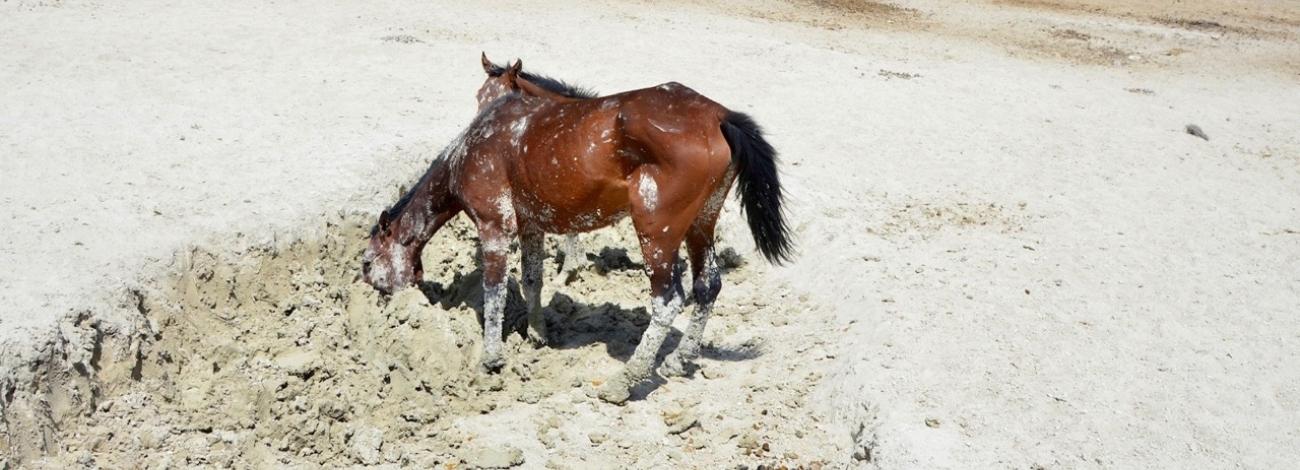
2024 Maverick-Medicine Emergency Wild Horse Gather
Purpose of Gather:
The purpose of the gather is an emergency removal of excess wild horses due to limited water and declining body condition. The small springs in the area produce only limited amounts of water and cannot support the current population. In order to prevent undue or unnecessary degradation of the springs and the public lands within the HMA the Agency must reduce the number of excess wild horses.
Details of Gather:
The BLM anticipates gathering and removing up to approximately 100 wild horses via bait-trap. No helicopters will be used.
Public Observation:
Due to the nature of the bait and water trap method, wild horses or burros are reluctant to approach the trap site when there is too much activity; therefore, only essential gather operations personnel will be allowed at the trap site during gather operations.
Adoption Information:
All animals identified for removal will be transported to the Indian Lakes Off-Range Corral in Fallon, Nevada. Upon arrival to the facility, all animals will be checked by a veterinarian and readied for the BLM’s Wild Horse and Burro Adoption and Sales Program.
Background:
The Maverick-Medicine HMA encompasses approximately 286,460 acres of public and private lands and has an Appropriate Management Level of 166-276 wild horses. The last inventory was in May 2023 and the current estimated population is 1,042. The most recent gather in the Maverick-Medicine HMA occurred in 2022, when 906 excess wild horses were removed.
The Maverick-Medicine HMA is located approximately 75 miles southeast of Elko. The HMA is 30 miles wide, 25 miles long. The highest point in the HMA is High Bald Peak at 9,396 feet in elevation. The lowest points can be found in the valley bottoms and playas and range from 6,000 to 7,000 feet. Between these high and low points, rolling juniper covered hills broken by sagebrush covered valleys make up the topography. Temperatures can be extreme, ranging from a high of 100 degrees Fahrenheit in the summer to well below 0 degrees in the winter months. The vegetation in the foothills and valley regions support desert shrubs such as sagebrush, spiny hopsage, horsebrush, shadscale and rabbitbrush mixed with many species of native grasses such as Indian ricegrass, squirreltail and bluebunch wheatgrass. The higher elevations support pinyon pine and juniper forests. At the highest elevations, fir and spruce trees are abundant.
- Daily Gather Reports
-
Monday, September 2 - The gather has concluded
Summary: n/a
Animals Gathered: 0
Animals Shipped: 25 (22 Stallions, 3 Mares, and 0 Foals)
Deaths: 0
Sunday, September 1
Summary: 47 to 88 degrees, smoke cover in the morning increasing clouds in the afternoon.
Animals Gathered: 8 (5 Stallions, 3 Mares, and 0 Foals)
Animals Shipped: 44 (26 Stallions, 36 Mares, and 19 Foals)
Deaths: 3
- Sudden / Acute: 1
- Pre-existing / Chronic: 2
12 y/o grey stud- Died: Acute, Toxicity - water
9 y/o bay mare- Euthanized: Pre-existing - extremely low body weigh with poor chance of recovery
3 y/o bay stud- Euthanized: Pre-existing - extremely low body weigh with poor chance of recovery
Saturday, August 31
Summary: 40 to 88 degrees, smoke cover in the morning increasing clouds in the afternoon.
Animals Gathered: 61 (19 Stallions, 27 Mares, and 15 Foals)
Animals Shipped: 37 (26 Stallions, 11 Mares, and 0 Foals)
Deaths: 0
- Sudden / Acute: 0
- Pre-existing / Chronic: 0
Friday, August 30
Summary: 43 to 88 degrees, smoke cover in the morning clearing to sunny skies with calm breezes.
Animals Gathered: *25 (*17 Stallions, 6 Mares, and 2 Foals)
(*Corrected number)
Animals Shipped: 0 (0 Stallions, 0 Mares, and 0 Foals)
Deaths: 0
- Sudden / Acute: 0
- Pre-existing / Chronic: 0
Thursday, August 29
Summary: Weather was 53-81 degrees and sunny with light breezes.
Animals Gathered: 15 (9 Stallions, 4 Mares, and 2 Foals)
Animals Shipped: 0 (0 Stallions, 0 Mares, and 0 Foals)
Deaths: 0
- Sudden / Acute: 0
- Pre-existing / Chronic: 0
News
Gather Status
As of September 2, 2024- The gather has concluded.
Animals Gathered: 109
109 Wild Horses (50 Stallions, 40 Mares, and 19 Foals)
Animals Shipped: 106
106 Wild Horses (48 Stallions, 39 Mares, and 19 Foals)
Deaths: 3
-Sudden / Acute: 1
-Pre-existing / Chronic: 2
Scroll to the bottom of this gather page for detailed “Daily Gather Reports"
